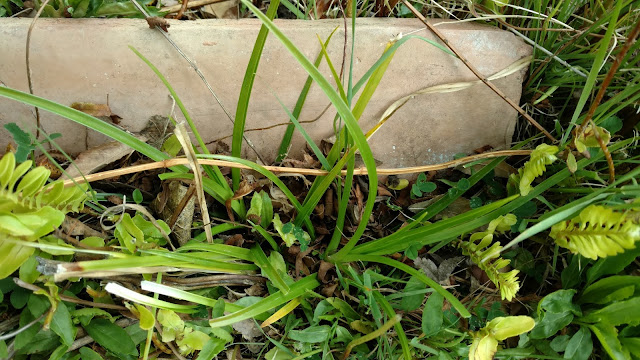
|
|
The sharp-edged leaves in the center of the photo belong to fast-growing
nutsedge plants near a sprinkler head. (Photo: Debbie Arrington)
|
What’s the worst weed in Sacramento? It depends on who you ask and what season.
Right now, one fast-growing candidate tops the list: Nutsedge.
Also called nutgrass, this tough perennial is sprouting like crazy, pulling energy from its underground tubers or “nuts.” Those tubers, which lurk about 4 to 6 inches below the surface, push out fresh growth once soil temperatures start to warm each spring.
That early growth looks like wide-bladed ornamental grass, but nutsedge is a true sedge, with thicker and sturdier leaves than grass. It spreads via equally tough rhizomes, or underground stems.
According to UC Cooperative Extension master gardeners, the most common variety in Sacramento is yellow nutsedge. Its close cousin, purple nutsedge, needs warmer temperatures to sprout and is more prevalent in Southern California, but can show up in Sacramento, too.
Once established, nutsedge is nearly impossible to eradicate due to those resilient rhizomes and tubers. The tubers can stay dormant three years and still sprout.
Like most perennials, nutsedge dies back in late fall or early winter, but never actually disappears. When it resurfaces with fresh spring growth, take action. Otherwise, the clumps will just continue to spread – up to 10 feet across.
“The best approach for avoiding nutsedge problems is to prevent establishment of the weed in the first place,” say the master gardeners. “Once established, nutsedge plants are difficult to control.”
Nutsedge particularly likes damp spots in the garden where water tends to collect.
“They thrive in waterlogged soil, and their presence often indicates drainage is poor, irrigation is too frequent, or sprinklers are leaky,” say the master gardeners. “Once established, however, they will tolerate normal irrigation conditions or drought.”
To fight nutsedge, grab a hoe. On the first pass, whack the young plants, aiming the hoe to hit about an inch below the soil line. Young plants also can be pulled by hand.
“If you hoe, be sure to dig down at least 8 to 14 inches to remove the entire plant,” adds the master gardeners. “Using a tiller to destroy mature plants only will spread the infestation, because it will move the tubers around in the soil. However, repeated tillings of small areas before the plants have six leaves will reduce populations. If you find nutsedge in small patches in your turf, dig out the patch down to at least 8 inches deep, refill, and then seed or sod the patch.”
Landscape fabric can be used under wood chip mulch to try and block nutsedge from emerging. But don’t use plastic mulch; the nutsedge’s pointy leaves will poke right through.
“Prevent establishment by removing small plants before they develop tubers, eliminating the wet conditions that favor nutsedge growth, using certain fabric mulches in landscape beds, and making sure nutsedge tubers aren’t brought in with topsoil or other materials,” say the master gardeners.
Herbicides are mostly ineffective against nutsedge because of those tubers.
Another approach: Take away what nutsedge needs most – water and sun. An area constantly plagued by nutsedge can be dried out over summer; but that also eliminates irrigation to anything else growing in that area. Or shade out the nutsedge by growing taller plants that hog the sunlight.
“Nutsedges don’t grow well in shade, so changing landscape plantings might reduce their growth,” say the master gardeners. “For example, a highly infested, annually planted flower bed might be better off if you replant it with a tall, dense ground cover or shrub. Low-growing ground covers won’t shade out nutsedge.”
If you can’t beat it, eat it. That’s a suggestion by Los Angeles garden writer Joshua Siskin, a UC Davis alumnus.
“Nutsedge may be the worst weed but it’s also the most palatable, owing to its tubers,” Siskin wrote. “The tubers may be boiled or roasted, eaten raw, dried, or ground and used for flavoring drinks and cookies. The taste will remind you of almonds. In Spain, ground tubers are combined with sugar, vanilla, cinnamon, water and ice to make a drink they call horchata de chufa.”
Remember, it’s only a weed if you haven’t figured out how to use it.
For more on nutsedge:
http://ipm.ucanr.edu/PMG/PESTNOTES/pn7432.html
and
http://ipm.ucanr.edu/PMG/WEEDS/nutsedge.html
.

